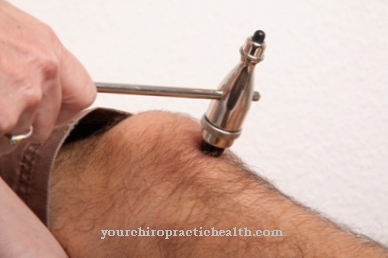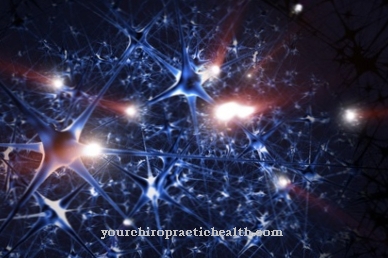The Rhythmic ability is the ability to adapt one's own rhythm of movement to a given rhythm. These coordinative skills are particularly relevant for sports medicine. It can be damaged by central nervous inflammation, bleeding, injuries or masses.
What is the rhythmic ability?

The sports medicine specialist understands rhythmic ability to be one of a total of seven coordinative abilities. Together with the ability to connect, adapt, differentiate and balance, as well as the ability to orientate and react, the ability to rhythmise enables a perfect interplay of nervous system and muscles. This perfect interaction is very helpful in everyday life and essential for sporting challenges.
A person capable of rhythmizing perceives a given movement rhythm, recognizes it and adapts his own movements to this rhythm. This adaptation of one's own movements to a given rhythm plays an increasingly important role in many sports, for example dance, but also ball sports.
Without the ability to adapt to a given rhythm, however, ultimately hardly any movement is possible - even outside of sport. For some time now, training units for various sports have often concentrated on training the ability to rhythmise.
Function & task
The coordinative abilities of humans enable the harmonious interaction between the sensory organs, the central nervous system and the muscles. Coordination makes targeted movements or targeted movement sequences from individual movement components possible in the first place.
Intermuscular coordination refers to the coordinated interaction of several muscles. This must be distinguished from intramuscular coordination, which describes the interaction between nerves and muscle fibers in a single muscle.
In addition to the flow of movement, the speed of movement and the precision of movement, the rhythm of movement provides information on a person's ability to coordinate. Together with the conditioning skills of strength, endurance and speed, the coordinative skills form the sports motor skills.
Athletic movement sequences are more complex than everyday movement sequences. They usually consist of significantly more, more precisely coordinated individual movements and usually require a maximum of inter- and intramuscular coordination.
The coordinative abilities of the human being determined above all whether a person is capable of learning sports techniques and sports skills and how good they will be in these techniques and skills. As part of the coordination skills, the ability to rhythmic also have these properties. The coordination of sensory perception and muscles is one of the most important components for the ability to rhythmise.
A good footballer, for example, perceives the speed of a ball through the interaction of his senses, through air noises and visual impressions. He is aware of his own spatial position and his own position in relation to the ball through impressions of the muscular sense and the sense of balance. He then adjusts his movements precisely to the rhythm perceived outside in order to achieve a specific goal.
For a dancer too, the ability to create rhythm plays a role, for example. He audibly perceives the rhythm of the music. He visually recognizes the movement rhythm of his dance partner. He adjusts his own rhythm of movement to these two rhythms.
The ability to rhythmise thus ensures the rhythmic design of one's own movements and enables meaningful movement structure through accentuation. Although the rhythmization requirements differ with the sport, those of another sport are usually easier to learn for a trained professional than for an inactive person.
You can find your medication here
➔ Medicines against concentration disordersIllnesses & ailments
The coordinative skills and thus also the rhythmic skills are not equally pronounced in every person. The ability to rhythm is to a certain extent bound to the smooth functioning of anatomical structures such as the central nervous system and the sensory system. The majority of all coordinative skills are acquired through practice, rather than innate.
This makes the rhythmic ability a learned and thus trainable ability. Senses can be sharpened, for example. This is especially true for the attention to movement rhythms. A poor rhythmic ability does not necessarily have to have a disease value.
For example, if a child is not particularly active and rarely moves, in adulthood they will generally have a poorer rhythmic ability than an active child - this is another reason why physical play and romping are beneficial.
In the same way, a competitive athlete has a better ability to rhythmic than the average. However, that does not make the average person's ability to create rhythm pathological.
So gradual differences are not unusual. Nevertheless, damage to the perception systems, damage to the central nervous system or damage to the muscle structures can make the ability to rhythm even more difficult or even impossible.
Strokes, for example, can affect both the perceptual system and the conductivity of the nerve tracts. If the motor nerve tracts are damaged, your own rhythm of movement can no longer be adapted to an external rhythm, as the commands from the central nervous system only reach the muscles with a delay.
Inflammation of the pyramidal and extrapyramidal nerve tracts in the spinal cord can also impair motor skills and thus limit the ability to rhythmise. The same applies to inflammation in the sensorimotor areas of the brain or in the cerebellum.
Demyelinating diseases also delay the conduction speed of the nerve costume. Diseases such as Parkinson's, Alzheimer's or ALS can even completely break down the motor centers of the central nervous system. Tumors and other masses in the brain or spinal cord may also have an impact on the ability to rhythmise.
Many neurological examination methods test the patient's coordinative abilities in order to assess and localize damage in the central nervous system.
Like all coordination skills, the ability to rhythmic generally decreases with age. This also applies if there are no central nervous disorders.
























.jpg)



